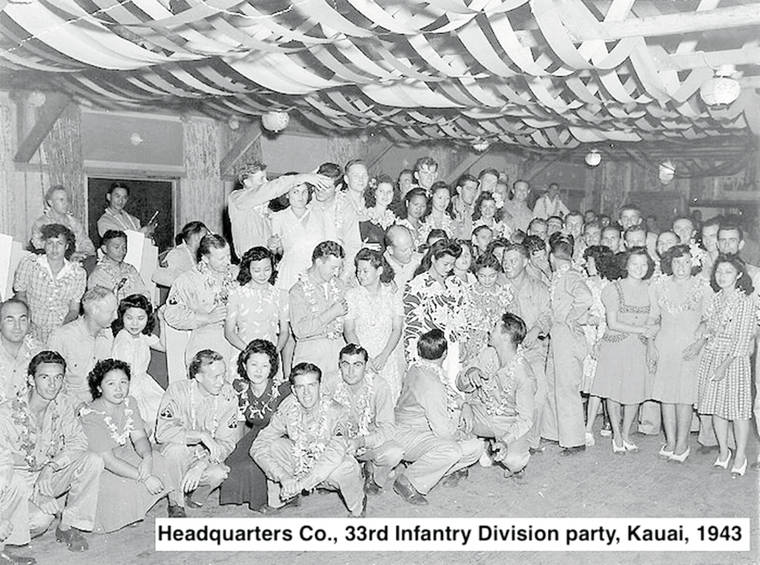During World War II, more than 40,000 American soldiers were stationed on Kauai, where the Army established camps, training areas, firing ranges and artillery impact zones for the purpose of training troops for combat in the Pacific.
Army units based on the Garden Isle during the war were the 298th and 299th Infantry regiments, elements of the 27th Division, of which the 165th Infantry was a part, the 33rd Division, the 40th Division, and two regiments of the 98th Division.
The Marine Corps constructed a base and firing range at Marine Camp in Wailua, but the Navy was not much in evidence on Kauai.
Unlike Oahu, where thousands of Mainland civilian war workers arrived to rebuild the destroyed Pacific fleet at Pearl Harbor beginning in 1942 – one of whom was my father, Henry Soboleski – Kauai received only a few skilled craftsmen.
By 1943, troops were present everywhere on Kauai in its plantation towns and along its roads and highways, where traffic was mostly comprised of military vehicles and where jeep-riding MPs patrolled after dark.
Soldiers were constantly training.
Firing of artillery was commonplace, and military aircraft flew over Kauai at all hours.
Some troops had been on Kauai for over a year and admitted they found the war a bit tedious and would either like to see some action or get home.
But, military personnel generally liked life better than on Oahu and preferred to remain on Kauai as long as they were in the Territory, yet they complained that there was not much to do in the towns when they were on overnight passes.
Many soldiers therefore put up with the hassle of long waiting lists and crowded civilian and Army interisland transport planes to spend five-day passes in Honolulu.
Kauai troops could drink beer at their base canteens and bootleg okolehao and pineapple moonshine could be procured, but no hard liquor was sold openly to troops anywhere on Kauai.
And, eight USO clubs were in service on Kauai during the war at Lihue, Kapaa, Nawiliwili, Hanalei, Hanapepe, Koloa, Kalaheo and Waimea.
•••
Hank Soboleski has been a resident of Kauai since the 1960s. Hank’s love of the island and its history has inspired him, in conjunction with The Garden Island Newspaper, to share the island’s history weekly. The collection of these articles can be found here: https://bit.ly/2IfbxL9 and here https://bit.ly/2STw9gi Hank can be reached at hssgms@gmail.com






What happened when 40,000 people left the island suddenly after the war? Did many of the soldiers stay? I’d love to hear the rest of the story!
My father was stationed on Kauai in 1943 for artillery training. He loved his time in Kauai and had many great memories of the place. Not being much of a drinker, and married, he wouldn’t have minded the lack of nightlife very much. But I do recall him telling stories of chasing feral goats and exploring the island as much as possible. My mother saved clippings from the Kauai Sentinel, which was an Army newspaper from the period. There was a cow with an oversized eye on the masthead, I guess the Army struggled with the Hawaiian pronunciations!
My dad, a young Lieutenant, met my mom in Kauai when he was with the 33rd. They wrote as much as they could during the war. Afterwards, they met in San Diego, went to Columbia SC and were married until Dad’s passing in 2000! Mom (Hilda Brum) was a 1942 graduate of Kauai High!
My father was on O’ahu during the war, but also spoke of Kauai alot. He was Army Air Force (not a pilot, I guess you’d say ground support) and may have had some association with the early RADAR equipment. I have many pictures, but no way to tell where many were taken. I’ve identified Wheeler AFB (before Dec 7), and what I think is Schofield Barracks, but other area look more rugged and less developed. Anyone that can help identify pictures, or are the pictures to compare to? I don’t know if he was ever stationed on Kauai, but maybe just spent a few trips there for other purposes. During Korea he did artillery training stateside, but I’m not sure if the AAF would have sent people to artillery training on Kauai.
My dad was stationed there in WW2 and loved it! He said he could walk a mile into the ocean and the water was only to his waist. He also said he climbed coconut trees and shook down the coconuts. When he was dying in the nursing home from cancer the thing he loved most were pineapple coconut shakes they’d make especially for him!